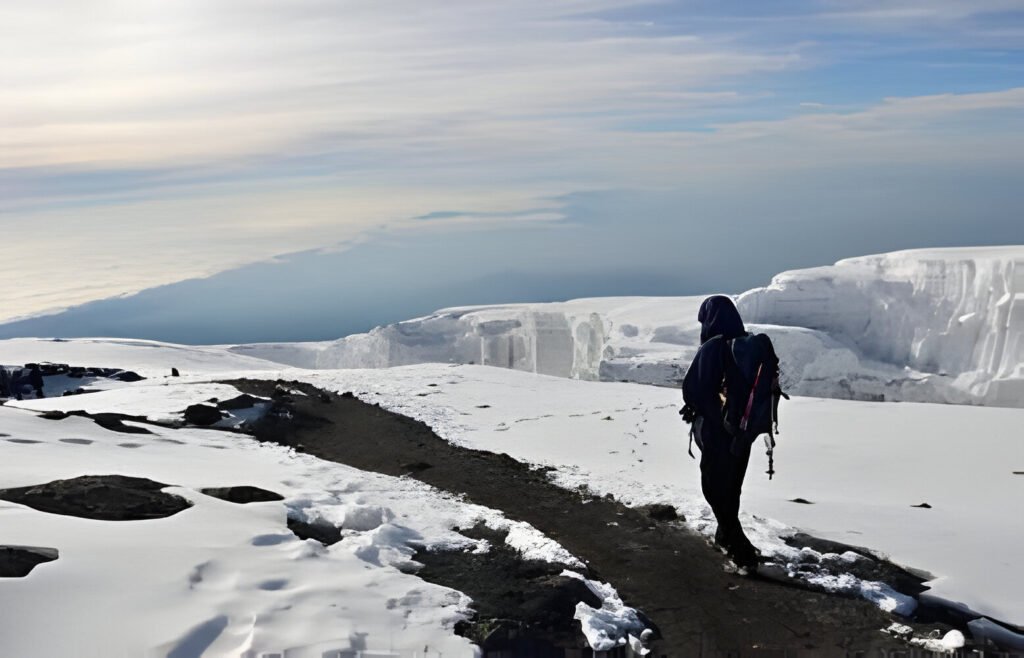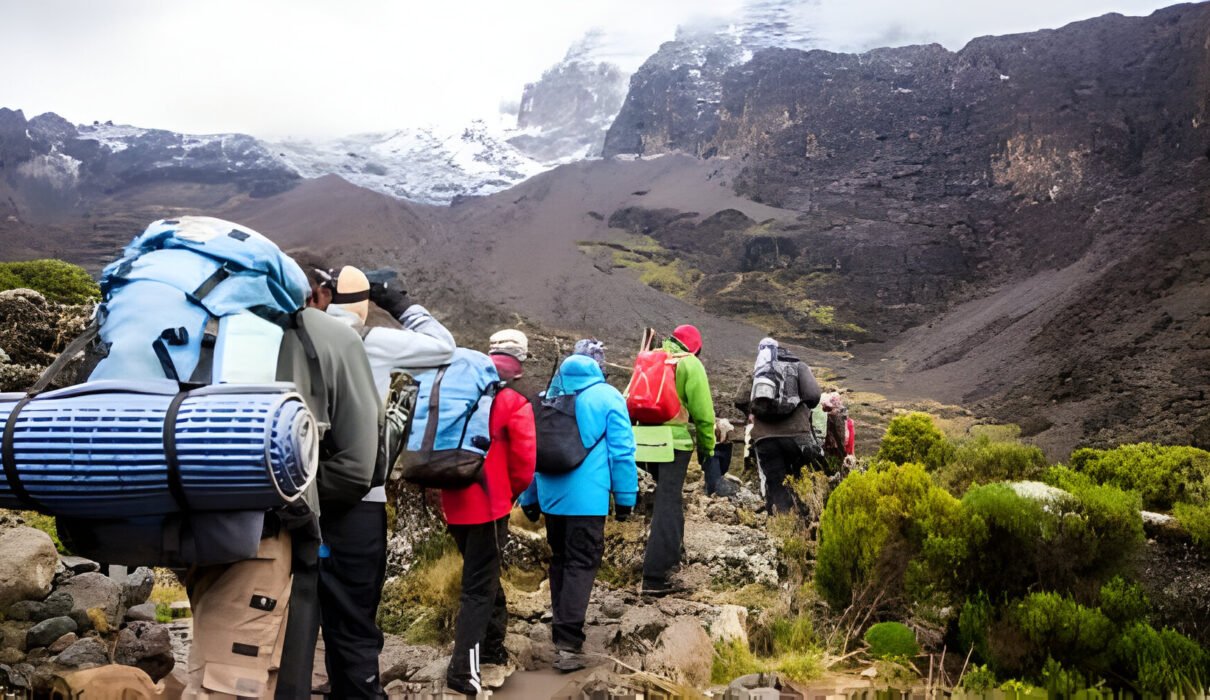Climbing Mount Kilimanjaro is an exciting adventure, but being well-prepared with the right clothing is crucial for a successful summit. Due to the varying climates you’ll encounter—ranging from tropical forests to freezing alpine zones—you need to pack strategically and use a proper layering system. In this guide, we’ll explain what to wear when climbing Kilimanjaro, the essential gear you’ll need, and how to pack efficiently for every climate zone.
Learn more about preparing for Kilimanjaro climbs here.

1. The Importance of Layering for Kilimanjaro Climbs
One of the most critical clothing strategies for climbing Kilimanjaro is the layering system. This system allows you to adjust your clothing based on the changing weather conditions as you ascend through five distinct climate zones, from rainforest to the arctic-like summit.
- Base Layer: Wicking material to keep sweat away from your skin.
- Mid Layer: Insulating layers, such as fleece or down jackets, to retain body heat.
- Outer Layer: A waterproof and windproof shell to protect against rain, wind, and snow.
Discover the best layering techniques for high-altitude treks.
2. Base Layer: Moisture-Wicking Essentials
Your base layer is essential for managing moisture and keeping you dry during the ascent. Choose lightweight, moisture-wicking materials like merino wool or synthetic fabrics. Avoid cotton, as it absorbs moisture and can make you feel cold as you climb higher.
- Best Materials: Merino wool or polyester.
- What to Pack: Long-sleeve tops and leggings that are breathable and quick-drying.
Learn more about choosing the right base layers.
3. Mid Layer: Insulating Fleece or Down
Your mid layer should provide insulation to retain body heat as temperatures drop, especially at higher altitudes. Fleece jackets or lightweight down jackets are ideal for trapping warmth without adding too much bulk.
- Fleece Jackets: A versatile option that’s warm, lightweight, and breathable.
- Down Jackets: Provide extra warmth for summit night when temperatures can drop well below freezing.
Find out how to choose the best insulating layers for cold climates.
4. Outer Layer: Waterproof and Windproof Jacket
Kilimanjaro’s weather is unpredictable, especially in the higher zones, where rain, wind, and snow are common. A durable, waterproof, and windproof jacket is essential to keep you dry and protect you from the harsh winds near the summit.
- Waterproof Jackets: Look for jackets made from Gore-Tex or similar waterproof, breathable fabrics.
- Windproof Protection: Ensure your jacket has a hood to shield you from wind and rain.
Check out this guide on choosing the best waterproof jackets.
5. Trekking Pants: Versatile and Comfortable
For trekking on Kilimanjaro, pack lightweight, quick-drying pants that provide comfort and flexibility. Convertible hiking pants are a great option as they can be adjusted into shorts during the warm, lower-altitude hikes and converted back to pants when the temperature drops.
- Hiking Pants: Choose synthetic, quick-drying materials.
- Thermal Pants: Pack thermal leggings to wear underneath as an insulating layer when it gets colder.
Explore more about choosing the best trekking pants.
6. Footwear: Sturdy Hiking Boots and Gaiters
Proper footwear is one of the most important items when climbing Kilimanjaro. Invest in a pair of well-fitted, waterproof hiking boots that offer good ankle support and have been broken in before the climb. Gaiters are also useful for keeping out debris and snow, especially on the higher, rockier sections of the mountain.
- Hiking Boots: Waterproof, with strong ankle support and a durable sole.
- Gaiters: Essential for keeping out mud, snow, and dirt.
Learn more about selecting the right hiking boots.
7. Hats, Gloves, and Buffs: Keeping Extremities Warm
The summit night can be extremely cold, with temperatures dropping below -20°C (-4°F). You’ll need to protect your head, hands, and face from the cold.
- Warm Hat: A fleece or wool beanie to keep your head warm at high altitudes.
- Gloves: Thermal gloves for insulation, with an outer waterproof shell for added protection.
- Buff or Neck Warmer: Useful for covering your face and neck to shield against the wind.
Find out how to protect your extremities during high-altitude treks.
8. Sunglasses and Sun Protection
Even though it can be cold at higher altitudes, the sun’s rays are much stronger. Protect yourself from UV radiation by wearing sunglasses with UV protection and using sunscreen to avoid sunburn, especially on summit day.
- Sunglasses: Look for polarized, UV-protection lenses.
- Sunscreen: High-SPF sunscreen is necessary, as well as a lip balm with SPF to protect your lips.
Learn more about choosing the best sunglasses for mountain climbing.
9. Essential Accessories: Trekking Poles and Daypack
Trekking poles are a great asset for maintaining balance and reducing strain on your knees, especially on the descent. A small, durable daypack is also important for carrying your essential gear, such as snacks, water, and extra layers, during your daily hikes.
- Trekking Poles: Adjustable poles are recommended for varied terrain.
- Daypack: Choose a lightweight, comfortable daypack with at least a 20L capacity.
Discover more about the benefits of trekking poles for mountain climbing.
10. Clothing for Sleeping and Rest Days
You’ll want comfortable, warm clothing to wear during the evenings when you’re resting at camp. Thermal underwear or a soft fleece set is perfect for sleeping in, as temperatures can drop significantly at night.
- What to Wear: Pack comfortable thermal tops and bottoms for sleeping, along with thick socks to keep your feet warm.
- Sleeping Bag: Ensure you have a sleeping bag rated for extreme cold temperatures (below -10°C or 14°F).
Find out how to stay warm and comfortable at night in high-altitude camps.
Conclusion
Knowing what to wear when climbing Kilimanjaro is crucial for a safe and successful summit. Using a proper layering system, investing in quality boots, and packing essentials like gloves, hats, and trekking poles will ensure you stay warm, dry, and comfortable as you ascend through Kilimanjaro’s diverse climates. With the right gear, you’ll be well-prepared to conquer Africa’s highest peak.
For more detailed packing lists and expert tips on preparing for your Kilimanjaro adventure, visit Kilimanjaro Climb Specialist or Eddy Tours & Safaris.

